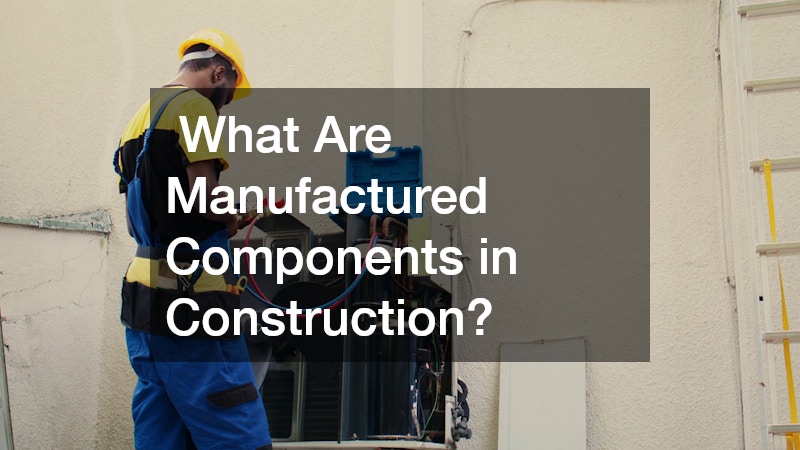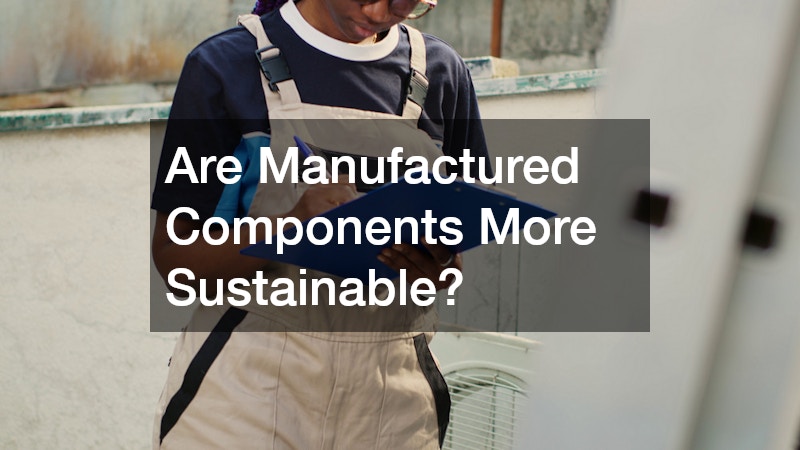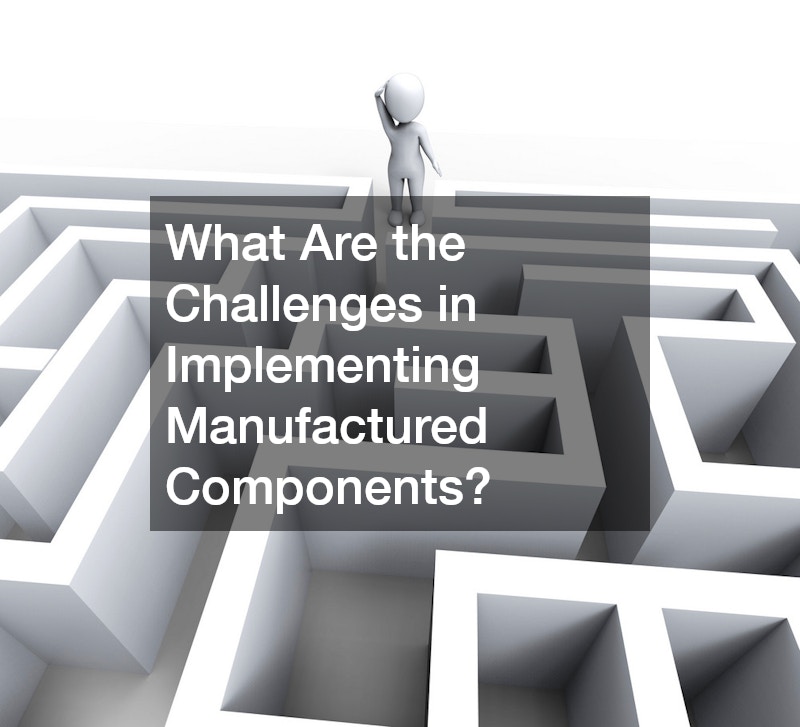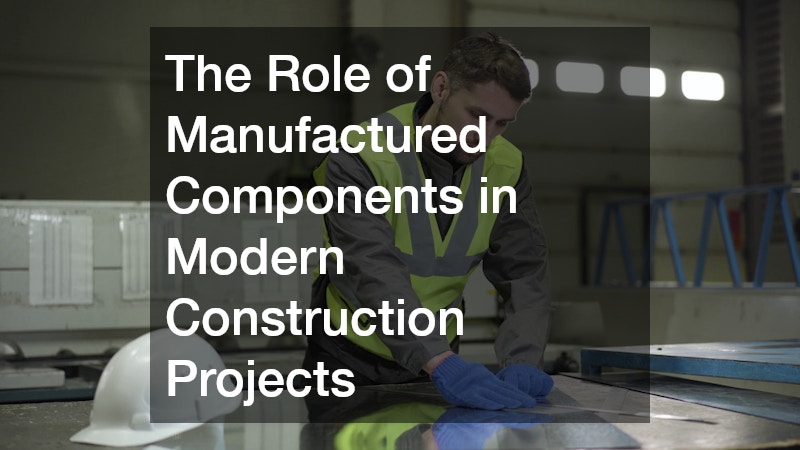As the construction industry evolves, manufactured components have gained unprecedented importance, transforming from a niche efficiency measure into a mainstream solution that is redefining how buildings are designed and assembled. Originally adopted to streamline workflows and reduce on-site labor demands, these components now serve as a cornerstone of innovation, influencing everything from project timelines to long-term building performance. In today’s fast-paced market, where speed, cost control, and sustainability are critical, manufactured components offer builders, architects, and developers a powerful tool to meet these demands without sacrificing quality. They integrate seamlessly with advancements in digital modeling, precision engineering, and automated production, enabling greater design flexibility and consistency across projects. In this exploration, we will delve into the multifaceted role of manufactured components in modern construction projects. Beyond their functional advantages, these components symbolize a broader industry shift toward smarter, faster, and more sustainable building practices that address the challenges of urban growth, resource limitations, and heightened client expectations.
1. What Are Manufactured Components in Construction?

Manufactured components refer to prefabricated building elements produced in factories that are later transported to construction sites. These elements range from simple wall sections to complex modules such as bathroom pods, façade systems, and mechanical racks. Advanced manufacturing companies have refined the planning, tooling, and quality checks behind these parts, enabling repeatable precision that traditional field-built methods rarely match. The results are tighter tolerances, better fit-up, and assemblies that integrate structure, envelope, and services in one deliverable.
Because components are fabricated offsite, teams can coordinate design and procurement earlier, reducing clashes and uncertainty in the field. In commercial construction and residential projects alike, this approach minimizes disruption, compresses schedules, and creates a more predictable path from concept to turnover. It also fits market realities: developers seeking speed to market, municipalities targeting housing supply, and owners prioritizing lifecycle value all benefit from a factory-first strategy that keeps quality high while maintaining cost discipline.
2. How Do Manufactured Components Enhance Building Efficiency?
Efficiency begins with parallel workflows. While foundations and site utilities proceed, modules and subassemblies are manufactured in controlled environments, insulated from weather delays and site congestion. This logistics model sharply reduces idle time and stacks critical path activities, which is especially valuable in dense urban areas where laydown space and access are limited. The gains are evident on concrete construction projects that use precast panels, volumetric cores, or pre-tied reinforcement cages to shorten critical pours and accelerate vertical progression.
Factory fabrication also limits rework. Standardized jigs, calibrated tools, and consistent crews create uniformity, so on-site installation becomes a sequence of connections rather than open-ended field craft. When envelope or MEP performance is central to the program, partnering with a commercial insulation contractor who understands component interfaces ensures thermal continuity and mitigates air leakage. This rigor reduces commissioning issues and helps projects achieve target energy outcomes without schedule slippage or costly late fixes.
3. What Impact Do Manufactured Components Have on Project Costs?
Cost advantages flow from predictability. Fixed tooling, lean workflows, and repeatable assemblies convert variable site labor into stable factory labor, reducing exposure to weather, overtime, and local trade scarcity. With clearer bills of materials and shorter installation durations, estimators can price work more accurately and owners can carry smaller contingencies. These factors improve underwriting assumptions on pro formas tied to absorption and rent commencement dates, which can influence decisions about pursuing tracts of commercial land for sale in competitive corridors.
Economies of scale further compress unit pricing as runs increase. Advanced manufacturing companies buy materials in volume, negotiate consistent lead times, and refine takt plans from project to project. Even accounting for shipping, cranage, and staging, the savings in field hours and general conditions typically offset premiums for specialized production. Where logistics are complex, planners may fold in allowances for large equipment rentals to handle deliveries and set modules safely and swiftly, preserving budget discipline while maintaining a brisk site tempo.
4. Are Manufactured Components More Sustainable?

Manufacturing in controlled facilities curbs waste at the source. Optimized nesting, standard lengths, and precise cuts reduce off-cuts, while take-back programs recycle scrap into future runs. Assembly indoors reduces site disturbance, cuts packaging, and limits truck trips by consolidating freight. These practices align with common green building targets and help projects demonstrate measurable reductions in embodied waste compared to ad hoc field fabrication.
Energy performance improves when assemblies are repeatable and testable before delivery. Advanced manufacturing companies can pressure-test duct sections, verify window performance, and confirm air barrier continuity under shop conditions, then document results for commissioning teams. Over a building’s life, durable, well-detailed components reduce maintenance interventions and extend service intervals. When redevelopment eventually occurs, consistent materials and known connections simplify selective removal, supporting safer, more efficient commercial demolition strategies and higher material recovery rates.
5. How Is Quality Controlled in Manufactured Components?
Quality assurance is embedded in the production line. Checkpoints verify dimensions, fasteners, sealants, and finishes at each station, and nonconforming items are corrected before they reach the loading dock. This approach contrasts with site-based punch lists, where access, weather, and sequencing can make fixes slow and disruptive. In the field, installers focus on alignment and connections because the assemblies themselves arrive with documented compliance to specifications.
Performance-sensitive systems benefit the most. Hardware borings, thresholds, and closer locations for commercial door hardware can be machine-cut with precise jigs, ensuring smooth operation and compatibility with access control. Similarly, pre-insulated spandrels and panelized rainscreens arrive with manufacturer-tested layers intact, minimizing field-applied variables. The net effect is a higher degree of certainty for owners and reduced warranty exposure for contractors who can trace components back to batch numbers and inspection logs.
6. What Role Do Manufactured Components Play in Modularity?
Modularity allows spaces to grow, shrink, or reconfigure with minimal disruption. By packaging structure, services, and finishes into interoperable blocks, teams can deliver initial phases quickly and then expand as demand rises. This is particularly effective for clinics, classrooms, and hospitality suites where standardized room types repeat and operational downtime carries a high cost. The approach also lends itself to podium and tower hybrids, where repetitive floors benefit from consistent parts and methods.
Because modules share interfaces, upgrades become surgical rather than wholesale. A tenant improvement may swap one pod for another or add a prefabricated stair without tearing apart adjacent work. Coordination with a knowledgeable commercial insulation contractor keeps thermal and acoustic performance intact at new junctions, while standardized details maintain façade rhythm and water management. The outcome is a building that can adapt over time without sacrificing performance or aesthetics.
7. Can Manufactured Components Adapt to Custom Design Requirements?

Standardization does not mean sameness. Parametric tooling and digital fabrication let teams vary dimensions, openings, and finishes within controlled envelopes. Architects can specify distinctive materials, profiles, or sightlines and still benefit from factory precision. Feature walls, soffits, and façade panels can be pre-assembled with integrated lighting, sensors, or shading, reducing the need for multi-trade choreography in the field and maintaining consistent fit and finish across the project.
Where bespoke touchpoints matter-lobbies, retail frontages, or premium units-manufacturers can produce tailored assemblies without abandoning repeatable subcomponents. Door sets, for example, can ship pre-hung with hinges, closers, and access-ready commercial door hardware, while still aligning with the project’s broader kit-of-parts strategy. The balance between flexibility and repeatability keeps design intent intact while preserving the schedule and cost advantages that make prefabrication compelling.
8. How Do Manufactured Components Impact Construction Timeframes?
Time compression is the signature benefit. Offsite production de-risks weather, shortens critical path activities, and reduces intertrade stacking that can bog down congested sites. Crews spend less time measuring and cutting and more time setting and connecting, which tightens day-to-day planning and improves safety by reducing improvisation. The resulting predictability helps downstream stakeholders-furniture vendors, IT integrators, and commissioning agents-lock schedules with fewer allowances for delay.
Turnover milestones land earlier and more reliably, which can coordinate smoothly with a commercial moving service tasked with phased occupancy. For developers, earlier rent commencement and quicker revenue recognition improve project economics. For institutions, earlier activation supports academic or clinical calendars. In both cases, the compounding effect of small time savings across many activities becomes a decisive advantage in competitive markets.
9. What Safety Considerations Are There with Manufactured Components?
Safety improves when work shifts from open sites to controlled shops. Factory floors have stable lighting, clear aisles, and dedicated fall protection, reducing exposures associated with heights, weather, and uneven terrain. Onsite, fewer cut-and-fit operations mean fewer hot works permits, less dust, and shorter durations in potentially hazardous zones. Craning well-planned loads in predictable sequences is safer than moving loose materials piecemeal.
Consistency also supports safe end-of-life practices. Known fixings, uniform panel sizes, and documented connections let commercial demolition teams plan methodical takedowns that protect adjacent properties and recover more material. From first installation to final removal, the clarity that comes with well-documented, repeatable assemblies strengthens jobsite controls and reduces uncertainty for contractors and owners alike.
10. What Are the Challenges in Implementing Manufactured Components?

Adoption requires new habits. Early design freezes, robust coordination, and disciplined change management are essential to reap offsite benefits. Teams must commit to detailed models, clear tolerances, and procurement timelines that front-load decisions. For some stakeholders, this shift can feel rigid, but it ultimately replaces late-stage uncertainty with early clarity and smoother execution in the field.
Logistics also demand attention. Deliveries must align with crane availability, street closures, and staging limits, and teams should budget for large equipment rentals to handle setting operations safely. Reliable supply of local forklift parts helps keep material handling equipment operational during tight installation windows, while trained rigging crews and rehearsed lift plans reduce risk. Finally, regional codes and inspection processes may require education and collaboration so that authorities understand how factory certifications map to site approvals and quality documentation.
Manufactured components are integral to modern construction, offering solutions that align with efficiency, sustainability, and evolving industry demands. Despite certain challenges, their ability to reduce costs, enhance quality, and provide modular flexibility sets them apart as transformative elements in building design and construction. As the industry moves forward, the role of manufactured components in shaping construction practices and possibilities looks set to grow even further, breaking new ground within the sector. In the long term, their influence could redefine not just how buildings are assembled, but how they are conceived from the design stage onward. By enabling architects, engineers, and contractors to collaborate more effectively from the outset, these components promote innovative approaches that can shorten project timelines while maintaining high standards. Their adaptability also positions them as a strategic response to labor shortages and rising material costs, two ongoing challenges in the construction landscape. Looking ahead, advancements in automation, digital modeling, and sustainable material technology are likely to amplify their benefits, making manufactured components an essential driver of a more resilient and forward-thinking construction industry that continues to appeal to owners evaluating commercial land for sale and to project teams partnering with advanced manufacturing companies to deliver consistent results.
From procurement through turnover, the approach hinges on clarity, coordination, and repeatability. With well-planned logistics, thoughtful detailing, and disciplined quality checks, project teams can shorten schedules, stabilize costs, and raise performance benchmarks across portfolios. Whether the scope centers on retrofit work or ground-up commercial construction, the combination of prefabricated parts, strong digital models, and experienced partners—spanning plant floors, site crews, and a trusted commercial insulation contractor—creates a durable framework for delivering buildings faster, safer, and with greater certainty than ever before. As projects move toward completion, the final stages are just as critical as the early phases. Aligning final staging with a dependable commercial moving service not only streamlines the transition from construction to occupancy but also helps maintain quality and schedule integrity right up to handover. This end-to-end coordination ensures stakeholders can transition seamlessly into operational use without disruption, safeguarding both project reputation and long-term building performance. Looking ahead, the integration of advanced manufacturing processes, refined project management tools, and cross-disciplinary collaboration will continue to redefine the delivery model for modern construction. By embedding these efficiencies into every phase, from material procurement to final setup, the industry can consistently meet the rising demands for speed, sustainability, and cost predictability. In an increasingly competitive marketplace, this holistic approach positions teams to not only meet but exceed client expectations—creating buildings that stand as proof of what thoughtful planning, precision execution, and strong partnerships can achieve.
